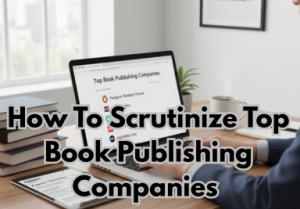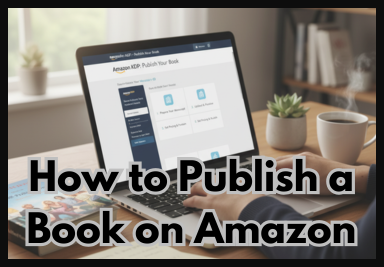Table of Contents
Dreaming of becoming a published author? With Amazon, that dream is closer than you think. Publishing a book on Amazon’s Kindle Direct Publishing (KDP) platform is a powerful way to share your story with millions of readers across the globe. This blog from Lincoln Book Publishing will walk you through the entire process of how to publish a book on amazon, from preparing your manuscript to making it available for purchase.
You’ll learn how to format your book, design an eye-catching cover, and navigate the KDP dashboard. When you write a book, get ready to turn your hard work into a tangible reality. Let’s bring your book to life and unleash your creativity onto the world.
How to Self Publish a Book on Amazon
For authors, self-publishing on Amazon is revolutionary because it has created a direct path from your keyboard to readers all over the world. It isn’t just about putting your book on a shelf, it is about taking command of your authorial destiny and learning how to self-publish a book.
You skip traditional gatekeepers and have full ownership of your work, from content to cover design. The amazon book publishing services are free, intuitive, and designed to help you succeed. It’s an empowering journey where you are the publisher, the marketer, and the visionary.
- You’re in the driver’s seat. You decide on the title, trim size, cover art, and price.
- Global reach is at your fingertips. Your book will be available to millions of readers on Amazon marketplaces worldwide.
- Earn a higher royalty rate. KDP’s business model allows you to earn a significant percentage of the sales price, a major advantage over traditional publishing.
- Start with ease. The process is streamlined, offering a straightforward path to publish both e-books and print copies with their print-on-demand service. No need to worry about inventory!
- This guide is your roadmap. We’ll navigate each step together, from formatting and uploading your files to setting up your author page and launching your book to the world.
What Does It Mean by Digital Book Publishing
Have you ever read a book on your phone, tablet, or computer? That’s digital publishing in action. It’s the modern way to bring a book to life, moving beyond the traditional constraints of ink and paper. The term refers to taking a written work in any medium (e.g. paper, type, etc.) to convert to a digital format, such as an eBook or PDF format, that can be read on electronic devices (e.g. Kindle, iPad, tablet, etc.).
This Amazon book publishing service has changed the book publishing world forever, making it faster, easier, and more environmentally friendly. Authors are not tied to a printing press and a distribution center anymore. Digital Book Publishing democratises the entire process. It enables the independent author to publish his or her written work immediately to a global audience without going through a traditional publisher. The latest, front-line technology companies, such as Amazon’s Kindle Direct Publishing, Barnes & Noble Press, and Apple Books, are leading the charge.
They provide the means to format, upload, and sell your digital book to hundreds of millions of readers. While this change has made publishing a more accessible concept, it has also entered into transforming how we consume literature – with digital technology, in a few clicks we can access an entire library of stories instantly. The future of reading is here.
How To Find Best Publishers for Books
Kudos! You have finished your manuscript. Now, the next big step is finding the perfect companion to bring your story to the world. Navigating the publishing landscape can feel like a complicated puzzle, but with the right approach, you can find a publisher who is a true champion for your work.
This isn’t just about getting a book deal, it’s about finding a home where your book will be nurtured, professionally edited, and strategically marketed. A great publisher will see the potential in your words and invest in your success. So, how do you find the one?
- Research Your Genre: Look at the books you love and admire. Who published them? Start with the books on your own bookshelf. Many publishing houses specialize in specific genres, ranging from literary fiction to science fiction and non-fiction.
- Study Publisher Catalogs: Visit the publisher’s websites to view their lists of upcoming and past books. Does your manuscript fit with their current titles? Are their book covers appealing? Do they have a clear brand and mission?
- Read Submission Guidelines: This is a crucial step. Every publisher has specific rules for submissions, whether they accept unsolicited manuscripts or require a query letter through a literary agent. Following their guidelines shows you are professional and serious.
- Use Reputable Databases: tools like QueryTracker, Publishers Marketplace, and The Writer’s Market are invaluable resources. They provide detailed information on publishers and agents, including what they are actively seeking and their submission policies.
- Go to Conferences and Events: Attending writing conferences and literary events is a fantastic way to network. You can meet with agents and editors face-to-face, gaining insight into their personalities and what they’re passionate about.
How To Scrutinize Top Book Publishing Companies

Once you have perfected your manuscript, the next hindrance is finding the ideal and right partner (top book publishing companies). This is more than just a business decision, it’s about choosing a partner to champion your work. A careful vetting process is essential to distinguish between a publishing house that will promote your book and one that will leave you with buyer’s remorse.
You’re looking for a company with a proven track record of success, ethical practices, and a serious passion for the stories they publish. Don’t be tempted by flashy promises, instead, scrutinize their history, reputation, and commitment to their authors. This due persistence is the key to a long and fruitful author-publisher relationship.
- Check Their Backlist and Frontlist: Look at the books they’ve already published. Do they align with your genre and tone? Are the covers and interior designs professional and appealing? A publisher’s past work is the best indicator of their aesthetic and market focus.
- Examine Their Distribution and Marketing: How do they get their books into the hands of readers? Do they have a robust distribution network with major retailers and libraries? A good publisher will have a strategic marketing plan that goes beyond simply listing your book on Amazon.
- Read Reviews from Other Authors: Seek out testimonials and reviews from other writers who have worked with the company. Websites like Writer Beware and forums on platforms like Reddit are invaluable for finding unfiltered feedback about a publisher’s communication, support, and royalty payments.
- Scrutinize the Contract: If you receive an offer, read the contract with meticulous care. Pay close attention to clauses regarding intellectual property rights, royalty rates, and any fees that may be charged. A fair contract is a sign of a reputable and trustworthy publisher.
What Are the Parts of a Published Book
Have you ever picked up a book and wondered what all those pages before and after the main story are for? The anatomy of a book is a thoughtful, intentional structure designed to guide the reader and provide essential context. It’s more than just the story, it’s a complete package, with each part playing a unique role in the reading experience.
From the moment you see the cover to the very last page, every element has a purpose, creating a seamless and professional presentation. Understanding these parts of a published book is the main key for any upcoming author, as they are the finishing touches that transform a manuscript into a published work. The book’s structure is divided into three main sections, each with its own set of pages.
- Front Matter: Its basically everything before the main content begins. It’s the first impression your book makes on the reader, delivering very essential information and setting the stage for the rest of the narrative. Pages in this section often have the title page, copyright page, a commitment to a loved one, and a table of contents to help readers navigate the book. A foreword or preface may also be included here to provide additional context.
- Body Matter: The main body of your book is where the real content lives, where the narrative unfolds or the information is laid out. This is the longest portion of your book, and it is typically divided into chapters, which help manage the narrative into bite sized pieces. In fiction, you might also find a prologue at the start or an epilogue at the end of this section, to provide context or a look to the future.
- Back Matter: Found after the main content, this section is a valuable space for supplementary materials. Back of book can have an afterword from the author, an appendix for more details, a bibliography for sources, or an acknowledgments page where the author thanks those who helped and supported them. An author’s bio is also often included here, allowing readers to learn more about the person behind the words.
How to Format Your Text into A Book
The moment you write a book with your heart out, unfortunately, you’re not quite done, it’s now the time for learning how to format your text into a book. Your bright manuscript needs to be converted from a simple document into a beautifully aesthetic formatted book.
This process, often referred to as “typesetting”, is where your words assume a professional, polished appearance. It’s all about designing a clean, readable, and visually beautiful layout that improves the reader’s POV experience.
Proper formatting is a crucial step that distinguishes a professional project from an amateur publication. It shows you’ve paid attention to every detail, ensuring your book is as enjoyable to read as it was to write.
- Choose the right software. Programs like Microsoft Word, Vellum, or Adobe InDesign can help you format your manuscript. Word is great for beginners, while Vellum is a powerful tool specifically for authors.
- Set your page size: Determine the trim size, which refers to the final physical dimensions of your book. Standard sizes include 6″ x 9″ for non-fiction and 5.5″ x 8.5″ for novels.
- Adjust your margins: Margins always create a clean frame around your text, controlling words from being cut off during printing. Please ensure that they are consistent across all pages.
- Select a readable font: Fonts like Garamond, Times New Roman, and Baskerville are traditional choices for body text. Avoid overly decorative or distracting mediocre fonts.
- Add page numbers, headers, and footers: These pretty elements give your book a skilled appearance and help readers navigate it efficiently. Always Ensure they are correctly placed and formatted throughout the document.
Conclusion
Provided by Lincoln Book Publishing, this blog post provides helpful information about how to successfully publish a book on Amazon. Publishing a book on Amazon creates great prospects for authors, thanks to Amazon Kindle Direct Publishing, you can bring your book to a worldwide audience at very little expense on the front end.
Focus your efforts on quality writing, quality marketing, and quality cover design. With effort and creativity, you can effectively get your story out into the world.
Frequently asked question
How Much Does It Cost to Publish A Book on Amazon?
Publishing a book on Amazon is free via Kindle Direct Publishing (KDP). However, costs may arise from editing, cover design, and marketing. Authors retain control over pricing and royalties, which can impact overall earnings.
Do I Need to Copyright My Book Before Publishing on Amazon?
While you don’t need to register copyright before publishing, your work is automatically protected as soon as it is created. Registering with the U.S. Copyright Office offers additional legal benefits, but it’s not mandatory for publication.
How Much Does Amazon Pay You Per Book?
Amazon’s royalty rates may vary. Authors typically earn 35% or 70% of the book’s sale price, depending on pricing and distribution choices. For eBooks priced between $2.99 and $9.99, the 70% royalty applies, offering higher earnings per sale.

Author
Frederic Shah is a skilled copywriter and ghostwriter with a passion for crafting engaging web content and eBooks. With over 11+ years of experience in the industry, he excels at translating complex ideas into accessible narratives that captivate diverse audiences. His background in Computer Science equips him with a unique perspective, allowing him to blend technical proficiency with creative storytelling. Whether he’s developing persuasive copy or insightful eBook content, Frederic Shah is dedicated to delivering high-quality writing that not only informs but also inspires readers to take action.


